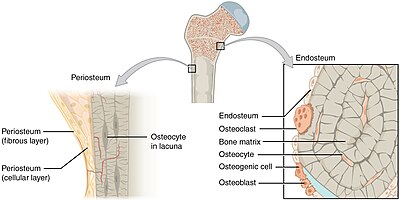Theendosteum(pl.:endostea) is a thin vascular membrane ofconnective tissuethat lines the inner surface of the bony tissue that forms themedullary cavityof longbones.[1][2]
| Endosteum | |
|---|---|
 Endosteum covers the inside of bones, and surrounds themedullary cavity. | |
| Identifiers | |
| TA98 | A02.0.00.038 |
| TA2 | 387 |
| TH | H2.00.03.7.00022 |
| FMA | 32692 |
| Anatomical terminology | |
This endosteal surface is usually resorbed during long periods ofmalnutrition,resulting in lesscorticalthickness.[citation needed]
The outer surface of a bone is lined by a thin layer of connective tissue that is very similar inmorphologyand function to endosteum. It is called theperiosteum,or the periosteal surface. Duringbone growth,the width of the bone increases asosteoblastslay new bone tissue at the periosteum. To prevent the bone from becoming unnecessarily thick,osteoclastsresorb the bone from the endosteal side.
Additional images
edit-
Long bone
References
edit- ^Netter, Frank H.(1987).Musculoskeletal system: anatomy, physiology, and metabolic disorders.Summit, New Jersey: Ciba-Geigy CorporationISBN0-914168-88-6,p.171
- ^"Definition of ENDOSTEUM".merriam-webster.
External links
edit- Anatomy photo: Musculoskeletal/bone/structure1/structure2- Comparative Organology at University of California, Davis – "Bone, structure (LM, High)"
- Image at dal.ca